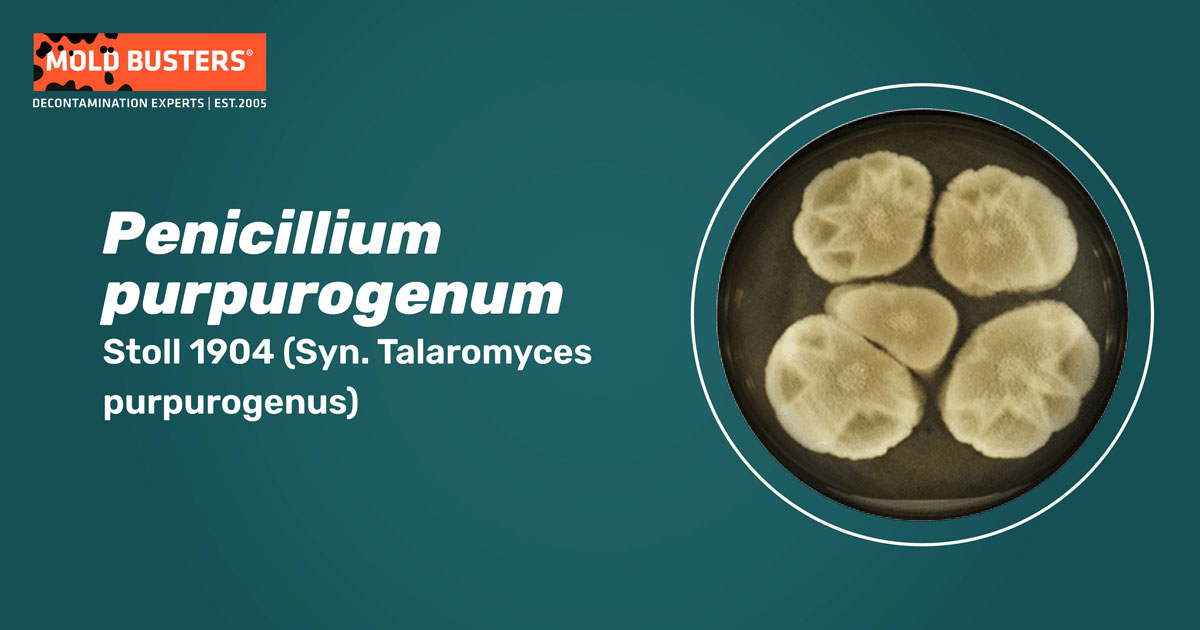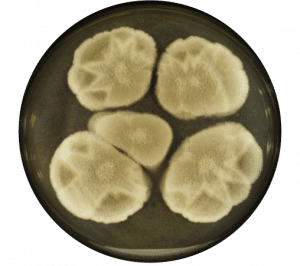Stoll 1904 (Syn. Talaromyces purpurogenus)
What is Penicillium purpurogenum?
Penicillium purpurogenum was originally described by Stoll; it is a soil and plant saprophytic fungus and is characteristic of producing red pigmentation on growing media. It is a non-toxic species, capable of growing at 37 °C (98.6 °F). P. purpurogenum was often confused with P. rubrum, and today we know it represents a species complex. P. purpurogenum is broadly distributed in terrestrial plants, soil, and marine habitats and is currently known by Talaromyces purpurogenus (1–3).

How does Penicillium purpurogenum look like?
Penicillium purpurogenum colonies on Czapek Yeast Autolysate Agar (CYA agar) are dense, often velutinous, red due to encrusted hyphae, or yellow (Fig. 1). Usually 10–30mm (0.4–1.2-inch) in diameter. Colonies formed on MEA agar are usually larger in diameter (22–35 mm (0.9–1.4-inch)) and denser, with white to bright yellow mycelium. The most striking characteristic feature of P. purpurogenum is an intense and rapidly diffusing red pigmentation on CYA media. Conidia are more abundantly produced on the MEA than on CYA medium and may give a greenish hue to the colonies (1,4).

Conidiophores (spore-bearing structures) are smooth, rising above the mycelium up to 300µm. They bear terminal once branched (biverticillate) penicilli. Penicillii are structures on which the conidia (asexual spores) chains are positioned. Conidia are ellipsoidal, 3.0–3.5 µm long and becoming spheroidal at maturity. They are borne on irregular chains and can have a smooth, slightly roughened, or warty surface (1,4).
What is the physiology of Penicillium purpurogenum?
Penicillium purpurogenum is an acidophilic microorganism and can be easily isolated on media pH even down to 2.0. Regarding its water needs, the species is mesophilic and requires app. 0.84 media water activity (aw). Minimum growing temperature falls at 12°C (53.6°F), while the optimum is at 30°C (86°F). The maximum growth temperature is around 40°C (104°F) (1,4).
Where can be Penicillium purpurogenum be found?
Penicillium purpurogenum is a well-known biodeteriogen and a notorious causal agent of fruit spoilage. Biodeteriogens are organisms capable of causing an undesirable change due to their metabolic activity. P. purpurogenum has been reported to cause spoilage of fruits such as pears and pineapples in Southeast Asia. The species has also been isolated but not cause spoilage from dried and stored commodities such as corn, rice, wheat, barley, and various nuts. The species is also mildly xerophilic (1,4).
Is Penicillium purpurogenum toxic?
Due to misidentification errors, it was believed that Penicillium purpurogenum is a producer of Rubratoxin B, a potent mycotoxin capable of serious liver damage the liver when consumed. However, today P. purpurogenum is regarded as a producer of glauconic acid rather than rubratoxins, while the identity of the toxin-producing strain is P. crateriforme. Rubratoxins can be mutagenic, splenotoxic, and nephrotoxic. On the other hand, rubratoxin B also has the potential as an antitumor agent (1,5).
Penicillium spp. are under normal conditions, rarely pathogenic, and usually cause infections in immunocompromised individuals. Only one species, P. marneffei, is the only pathogenic species that can cause infections in healthy individuals and immunosuppressed patients. In only several cases, P. purpurogenum has been reported as the causative agent of pulmonary infections, all of which had an underlining disease. These underlying disorders were chronic granulomatous disease, acute myeloid leukemia, or multiple myeloma (1,6). Furthermore, P. purpurogenum is a typical species found in homes with water damage and is therefore listed in the Group 1 of the ERMI (The Environmental Relative Moldiness Index) list of potentially hazardous fungi (9).
What are benefits of Penicillium purpurogenum?
Penicillium purpurogenum produces several secondary metabolites such as meroterpenoids, polyketides, lipopeptides, and sterols. It is an important species for the biotechnology industry as it can produce enzymes such as xylanases and cellulases, which are needed to produce biofuels. Also, secondary metabolites extracted from P. purpurogenum display a wide array of bioactivities such as anti-inflammatory, anti-influenza virus, insecticidal, antitumor, and antifungal activities (1,7,8).

Did you know?
The #1 toxic mold type found in kitchens in Canada is the Penicillium/Aspergillus mold group?! Find out more exciting mold stats and facts on our mold statistics page.
References
- Yilmaz, N., Houbraken, J., Hoekstra, E. S., Frisvad, J. C., Visagie, C. M., & Samson, R. A. (2012). Delimitation and characterisation of Talaromyces purpurogenus and related species. Persoonia: Molecular Phylogeny and Evolution of Fungi, 29, 39.
- Stoll O. (1905). Contributions to the morphological and biological characteristics of Penicillium species – A Borst Print house
- Avasthi, S., Gautam, A. M., & Bhadauria, R. (2015). First report of Penicillium purpurogenum causing collar and root rot infection in Aloe vera. Plant Pathology and Quarantine:, 5(1), 20-24.
- Pitt JI, Hocking AD. Fungi and food spoilage. Vol. 519. Springer; 2009.
- Wang, T., Zhang, Y., Wang, Y., & Pei, Y. H. (2007). Antitumor effects of Rubratoxin B on cell toxicity, inhibition of cell proliferation, cytotoxic activity and matrix metalloproteinase-2, 9. Toxicology In Vitro, 21(4), 646-650.
- Atalay, A., Koc, A. N., Akyol, G., Cakir, N., Kaynar, L., & Ulu-Kilic, A. (2016). Pulmonary infection caused by Talaromyces purpurogenus in a patient with multiple myeloma. Infez Med, 24(2), 153-7.
- Belancic, A., Scarpa, J., Peirano, A., Díaz, R., Steiner, J., & Eyzaguirre, J. (1995). Penicillium purpurogenum produces several xylanases: purification and properties of two of the enzymes. Journal of Biotechnology, 41(1), 71-79.
- Wang, W., Wan, X., Liu, J., Wang, J., Zhu, H., Chen, C., & Zhang, Y. (2018). Two new terpenoids from Talaromyces purpurogenus. Marine drugs, 16(5), 150.
- Vesper, S., McKinstry, C., Haugland, R., Wymer, L., Bradham, K., Ashley, P., … & Friedman, W. (2007). Development of an environmental relative moldiness index for US homes. Journal of Occupational and Environmental Medicine, 49(8), 829-833.

Get Special Gift: Industry-Standard Mold Removal Guidelines
Download the industry-standard guidelines that Mold Busters use in their own mold removal services, including news, tips and special offers:

Written by:
Dusan Sadikovic
Mycologist – MSc, PhD
Mold Busters
Fact checked by:
Michael Golubev
General Manager
Mold Busters
